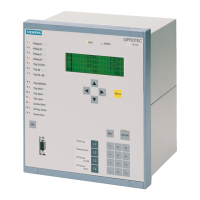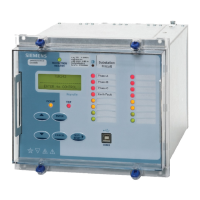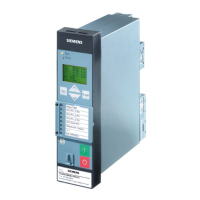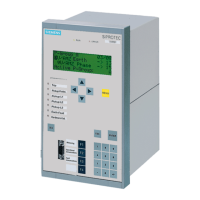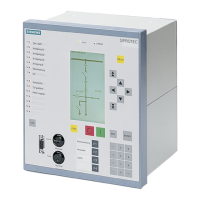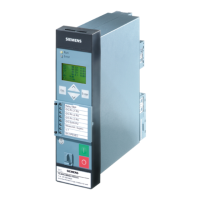7UT51 v3
Field Testing and Commissioning
18
PRIM-2330C 205
18.5 Leaving Test Operation,
Address Block 4800
When the relay is in test mode, the differential
protection and the restricted ground-fault protection
are not effective, even when they are switched
On
.
When no activities are carried out during more than 60
minutes, the relay terminates the test operation
automatically. All protection functions that are
switched
On
are then operational again. It is
nevertheless recommended that the test mode be
definitely finished after the tests have been completed.
• Access Address 4800 –
COMMISSIONING TEST
STOP
• Page to Address 4801 –
TEST STOP?
• Enter
YES
key
18.6 Checking The Coupling
of External Trip Signals
If the coupling of external functions for alarm and/or
trip processing is used in 7UT51, then one or more of
these functions must be configured as EXISTENT in
addresses 7803 and/or 7831. Additionally, the
respective function must be switched to
Block Trip
Rel
in Address 3001 and/or
3101 Ext. Trip*
.
The operation of the coupling is to be checked for
each function one after another. For this check, the
source object of the coupled signal is operated and the
effect is checked.
Finally, the required functions are parameterized to
On
in the associated addresses 3001 and/or 3101.
If further annunciations such as Buchholz protection
signals or user definable annunciations are used,
these, must be checked. The origin of each
annunciation is operated and the reaction of the relay
is checked.
18.7 Operational Checks
Operational checks are performed after wire checking
is complete and primary current tests are performed.
First, the differential protection is switched to
Block
Trip Rel
or the trip commands to the circuit breakers
are interrupted.
If trip test switches are installed in the circuit, these
initial checks are performed with the trip test switches
in the open position. If no trip test switches are
installed, disable/block relay trip output.
Verify that all relay and lockouts are reset.
Once the current circuits and relay operations are
verified, the major equipment such as circuit breakers
and air break switches can be checked for proper
operation. With the 86 relay in the trip position, close
each test blade separately. When the test blade is
closed, its corresponding piece of equipment will trip.
Once tripped, check and verify all interlocks for correct
operation.
After verifying all tripping from the lockout (86) through
the test blades, all external tripping of the 86 relay is
performed.
An overall operational test should be performed to
give a final system check. No part of the control
scheme should be assumed correct. Test every input,
output and function to verify that it operates
independently and also in conjunction with the total
scheme.
Once all checks are complete, check for zero (0)
voltage across the relay trip test switches with a DC
voltmeter.

